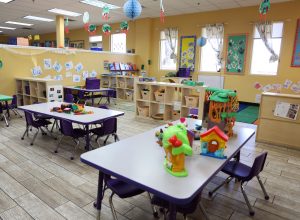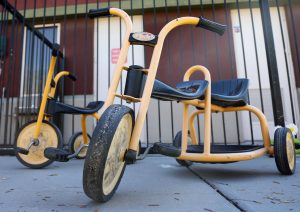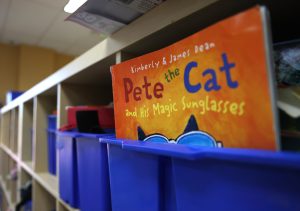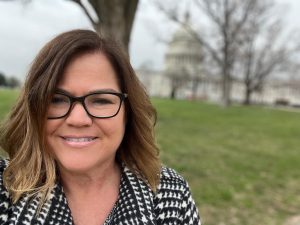- Slug: BC-CNS-Early Child Funding. 1,800 words.
- Photos available.
By Annika Tourlas
Cronkite News
PHOENIX – Early childhood care and education programs struggled to recruit, retain staff and meet labor costs before the COVID-19 pandemic. Then the worldwide shutdown made matters worse, as parents turned their homes into conference rooms, classrooms and day care centers.
According to the Annie E. Casey Foundation’s 2023 Kids Count Data Book, 16% of children 6 and under in Arizona had a family member quit, change or refuse a job because of child care problems. In fact, the 2023 report ranked Arizona 39th overall for child well-being, noting an annual cost of $10,883 for “center-based child care.”
“Families struggled to find affordable child care, child care programs struggled to keep up with their labor costs, but once the pandemic hit everything, you know, everything, all these problems just got bigger,” said Heidi Walton, program specialist at First Things First.
First Things First, Arizona’s Early Childhood Development and Health Board, invests funds to improve and maintain early childhood care across the state. Many of its funds come from a tobacco tax approved by Arizona voters in 2006. In 2021, the Arizona Department of Economic Security (DES) received $1.3 billion in additional federal funding for its Child Care and Development Fund from the Coronavirus Aid, Relief, and Economic Security Act, the Coronavirus Response and Relief Supplemental Appropriations and the American Rescue Plan Act of 2021.
The federal funds were used by First Things First to expand Quality First, a quality rating and improvement program. Quality First services were extended to an additional 400 care centers across the state that had high ratings for providing quality care for families and children in the care of the Department of Child Safety.
The DES also increased child care reimbursement rates from 35% to 50% for programs with at least a three-star rating and allocated funds to increase Quality First scholarships for essential workers and for families who could not afford care. All of these efforts worked together to eliminate the list of families waiting to get access to the facilities rated by Quality First.
But with federal pandemic relief funds set to expire on June 30, child care accessibility and affordability could be at risk for both families and care providers, as scholarships and increased reimbursement rates shrink.
Families face child care dilemma
Jacqueline Cordera is particularly worried about the loss of those relief funds.
When Cordera prepared to enroll her daughter in the same preschool her son attends, Imagination Childcare and Preschool in Litchfield Park, she realized she couldn’t afford it.
“I go back to work relatively quickly after I have my children just because I can’t afford to be off,” Cordera said. “So when it came to putting my daughter in, it was just, well, how the heck am I going to do this? Like, am I going to have to start working or stop working?”
The director of the facility directed Cordera to Quality First, where she got scholarships that let her put both children in the school. But she worries for the future as funds are set to expire.
“You have no idea what to expect,” Cordera said. “We’re just kind of sitting here waiting and wondering what’s going to happen and if we’re going to have to pull our kids from day care to find something else we can afford.”
More than 1,300 care and preschool providers benefit from Quality First funding. Staff members receive professional development training and guidance on center improvements. Funds can also be used to improve a facility’s library and learning materials, classroom furniture, outdoor equipment and building maintenance. Care centers have access to Quality First health care, mental health and special needs experts to meet the varied needs of students.
Before pandemic relief funds came into play, hundreds of families and providers had to wait for care; the looming expiration of pandemic relief funds could place those providers and families back on the waitlist. Families may lose scholarships or access to a Quality First-rated care center or preschool.
Some Arizona legislators are looking at ways to allocate funds for early childhood care across the state. Gov. Katie Hobbs proposed investing $100 million from the general fund for child care in her fiscal 2025 budget earlier this year. DES press secretary Tasya C. Peterson said efforts like this are essential to support quality child care in Arizona.
Raising the bar
While the 2020 Kids Count Data Book ranked Arizona 42nd for overall child well-being, the state rose to 39th in the 2023 Kids Count Data Book, boosted by decreases in the percentage of kids living in poverty, kids raised by single parents, teenage pregnancies and kids whose parents don’t have a high school diploma. Still, Arizona’s consistently low rankings are attributed in part to children living with high housing costs, children whose parents don’t have stable jobs and young children not attending school.
Child care advocates emphasize the need to adjust provider-to-child ratios in care centers and increase affordability.
Barbie Prinster, executive director for the Arizona Early Childhood Education Association, and Kelley Murphy, vice president of policy at the Children’s Action Alliance, worry about the threat that unaffordable child care poses to employers.
“It’s a business issue,” Murphy said. “It’s an economic development issue for the state. If I’m an employer and I need employees who can’t get child care, they can’t come to work. We can’t attract business to the state if we can’t hire employees.”
According to Murphy, some families pay 20% to 30% of their income on child care, leaving many to decide between child care and unemployment. Scholarships can help some families, and child care assistance from the DES is available to families at or below 165% of the poverty level, but those above that income level have to find assistance elsewhere.
Bill Berk, CEO of Small Miracles Education, said 90% to 95% of families at Small Miracles will be hit hard by the loss of pandemic relief funds. Small Miracles owns 15 preschools across the state, many of which offer education for low-income families with the help of Quality First.
“One of our core beliefs for Small Miracles is that every child deserves a high-quality learning experience and we hope that our schools can appeal to families of all demographics,” Berk said.
According to First Things First, 90% of a child’s brain develops by age 5. Preschools and day care centers that offer early social and learning opportunities can help prepare children for kindergarten and further education, according to industry advocates and professionals.
The HighScope Perry Preschool Project, started in 1962, tracked kids who participated in high-quality early learning programs and found they had a 19% lower arrest rate than kids who did not. Children in the control group who weren’t in the program were five times more likely to engage with the criminal justice system.
“Research tells us that kids that have high quality, early education experiences, arrive at kindergarten more ready to learn,” Murphy said. “They tend to have higher third grade reading scores, which then goes on to mean that they are more likely to graduate from high school, which means they’re less likely to end up in the prison system or on welfare.”
Child care experts say maintaining high-quality early childhood education is critical for the development of future generations. The Pima Early Education Program Scholarship works to improve access and affordability of care throughout the county, but legislators and providers want to see stable funding on the state level.
With the June 30 deadline approaching, providers are wondering how to help families navigate the potential loss of child care assistance.
“We really don’t know what’s going to happen after that,” Prinster said. “That’s been the hardest, I think, thing to swallow.”
Sidebar: The national picture of child care access and affordability
Arizona’s struggle to keep providing affordable, quality child care is duplicated all across the country. The Annie E. Casey Foundation states quite plainly that America’s child care system is broken and that its inherent disparities “reflect long-standing structural inequities in the U.S.”
The annual cost for child care is as high as $24,396 in the District of Columbia, while in Mississippi, it costs $4,382, according to the 2023 Kids Count Data Book. Meanwhile, the cost of care in Arizona is $10,883,very close to the national average of $10,600.
The Children’s Defense Fund, a national advocacy and service organization, analyzes the state of child care in its Children’s Defense Fund State of America’s Children Report every year. Bob Farrace, the fund’s national director of public affairs, said that child care hasn’t improved in the last decade, despite research showing the significance of early childhood brain development.
“We found child care remains inaccessible for too many families living in poverty at a time when there’s too little investment to relieve them of child care’s already high costs,” Farrace said.
Farrace cites the current federal definition of affordable child care as being no more than 7% of a household’s income, yet the fund found that in all but seven states, single parents may have to spend up to a third of their income on it. He concluded that child care is unaffordable for both married and single-parent households in every state.
History of government funding for child care
The nonprofit Bipartisan Policy Center outlined a history of government funding for child care that started in 1933, during the Great Depression, with the Emergency Nursery School Program providing care for children of Works Progress Administration workers. The timeline jumps to World War II, when funding was used for children of mothers working in defense and defense-related industries.
The Head Start program, started by President Lyndon Johnson in 1965 as part of the War on Poverty initiative, reflected a new focus on providing early education to promote school readiness. Head Start has evolved but still exists today in the form of grants given directly to local Head Start grantees, who offer services to support school readiness.
In 1990, the Child Care and Development Block Grant improved access to early childhood care by providing child care subsidies to working families with incomes too high to receive Aid to Families with Dependent Children support. The block grant program provides child care support for children and their families through state, territorial and tribal governments.
This year on March 1, the Department of Health and Human Services announced increased support for the Child Care and Development Block Grant by improving provider payment rates and simplifying enrollment in the child care subsidy program. For instance, the rule makes it easier to waive copayments for families living at or below 150% of the federal poverty level, families with children in foster and kinship care, families with children with disabilities and other populations.
Despite general support for publicly funded childhood programs, there’s disagreement on how to implement and amend these programs.
The Children’s Defense Fund urges policymakers to hear the stories of families and caregivers experiencing the impacts of increasing child care costs. Investing in early childhood programs like Head Start and expanding the child tax credit can help the nation’s children thrive, according to Farrace.
“Simply put, the same remains true today as it did a decade ago in terms of child care: We can afford to do better in America, and we must,” Farrace said.








